Post #1, “May, June, July: the dailiness of life”
Pamela J. Snow Sweetser
Backstory
“May, June, July: the dailiness of life” from Gramie Sweetser Drove a REO: diaries of an Aroostook County, Maine, farm wife, 1920-1956, is the first of a series that follows the contours one woman’s life over the seasons of a year. The posts draw from my research on rural women’s household work.
In 1970, I earned a bachelor’s degree in English, and some years later a master’s degree in Colonial U.S. History. Around 2001, I undertook PhD studies at the University of Maine to extend my Masters’ thesis about cattle in the Massachusetts Bay Colony. However, major life changes (‘new’ husband) introduced me to the Sweetser family diary collections which are the subject of this weblog. I abandoned the cattle and fell into the lives of Adwina O’Brien Richardson and Amy Richardson Sweetser, great grandmother and grandmother to my husband, Wayne Sweetser.[1]
My findings yielded a gendered story of place: “The harder I work, the more there is to do,” Aroostook’s rural women respond to the forces of modernization, 1870-1940, an ongoing exploration of how women far from the cutting edge of social changes reacted to the forces of modernization. The untimely loss of my extraordinary advisor, Adelaide & Alan Bird Professor of History at the University of Maine, Marli F. Weiner, (1953-2009), followed by more unanticipated events and snarls, threw my PhD progress into disarray. Nonetheless, I continued my research as an independent scholar.
Since 2006, I have presented annually at events such as the Rural Women’s Studies Association Triennial Conferences, the Deerfield-Wellesley Symposium, the Dublin Seminar for New England Folklife, and the Norlands Conference. My historical and educational articles have been published by Boston University Press, Yale University Press, and the National Council of Teachers of English. Most recently I contributed two essays with recipes to the RWSA 2021 publication, Backstories: The Kitchen Table Talk Cookbook, Cynthia Prescott and Maureen Thompson, editors.

March, 2021. Tailgate tea-time after a good outing on snowshoes. Courtesy of the author.
Reflexivity
I physically experience farm life in the context of the research I conduct, and I often reflect on the lives of women in this same place when it was in its ascendancy. Our farmhouse was Amy Sweetser’s home. I use her surviving laundry tools to wash wool from my sheep. I ride and drive my horses on the same roads and fields she traveled. Like Amy Sweetser and other farm wives who lived in Aroostook, I spin wool and make soap; plant and weed gardens, gather eggs; and preserve summer’s fruits and vegetables.
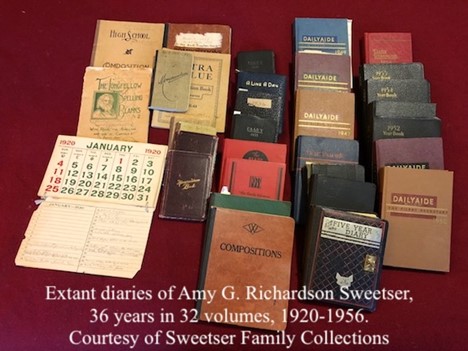
The Place
Maine’s Aroostook County, bordered on three sides by Canada, occupies the entire top tier and more than 20% of the state. According to the US Census, in 1920 its 6,828 square mile expanse was home to 81,728 people. Today’s population is 67,055. Amy Sweetser lived in Presque Isle and Maysville during that robust period when Aroostook County ascended from a logging hinterland to the “Garden” of the state, and then to “Potato Empire” of the world.
Amy and Elvin Sweetser’s 100 acre farm on the Higgins Road was 3 miles from Main Street in Presque Isle. Now known as Raymond Brook Farm, the house, barns, and out buildings are still in use.
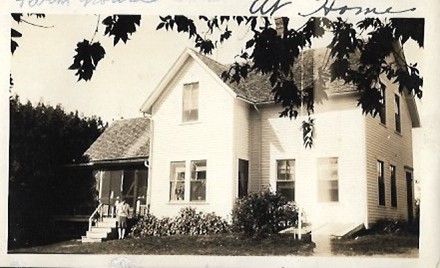
Courtesy Sweetser family collections.

Photo courtesy Paul Cyr Photography, Presque Isle, ME.
May, June, July: the dailiness of life
Among the many, many brilliant women who have influenced my writing is Bettina Aptheker. Her Tapestries of Life, Women’s Work, Women’s Consciousness, and the Meaning of Daily Experience (Amherst: University of MA Press, 1989) helped me analyze and understand that slippery expression, women’s work. Aptheker identifies the “dailiness of women’s lives” as the way(s) women shoulder perpetual emotional and physical responsibilities while coping with a persistent undertow of disruptions. Conditions of personal resilience, culture, race, class, age, gender, income, social status, relationships with men and with other women influence how women manage[d], or fail[ed] to manage, the disparate and often paradoxical elements of personal, family, household, community or professional work.[2]
The “dailiness” of Amy’s work was anchored to the rhythms of life and the turn of the seasons on a farm. Every week, month, season was the same, yet every day was different. No day passed without cooking, kitchen tasks, and children. Monday was always dedicated to laundry, and Tuesday to ironing. Wednesday through Saturday were for cleaning, sewing, food processing and preservation, shopping, charities and clubs, social and civic duties. Sunday spelled church. Except for disruptions. A rainy Monday threw off the laundry schedule, which postponed Tuesday’s ironing. Children got sick or had time-dictated activities to attend, particularly as the school year wound down. Mother herself sometimes got sick.
May, June, July were arguably the most intense months on the farm. Success or failure foretold how the rest of the year would likely go. Good results with foraged fiddleheads, dandelion greens, and berries (all to be preserved), cooperative weather for putting in gardens and field crops, the hay crop done by mid-July, made other matters easier to accomplish.
Mrs. Elvin Cyrus Sweetser had the advantage of an upbringing that prepared her for the demands of being a farmer’s wife. Born Amy Geneva Richardson on January 12, 1876, to Adwina O’Brien Richardson and Charles Richardson, she had an older sister, Mary Elizabeth (Lizzie). The Richardsons were a prosperous and prominent Maysville family.
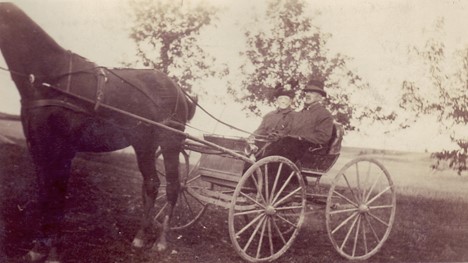
Courtesy Sweetser family collections.

Courtesy Sweetser family collections.
The two girls grew up in a household where education, theater, good clothes, social reform and civic duty, music and evangelical religion, and a strong work ethic, wove the fabric of their lives. In their world gendered roles and responsibilities were clear but not inflexible. Despite their material comforts and social advantages, the Richardsons were not inclined to take their good fortune for granted.
From Addie’s diaries, we learn much about Amy before 1920. She loved her family deeply and was well loved by them. On Friday, January 12, 1883, Addie wrote: . . . Amy’s birthday! She is seven and our darling baby still. Made her a cake and dressed her up, and Grandpa got her a candy treat.”

Courtesy Sweetser family collections.
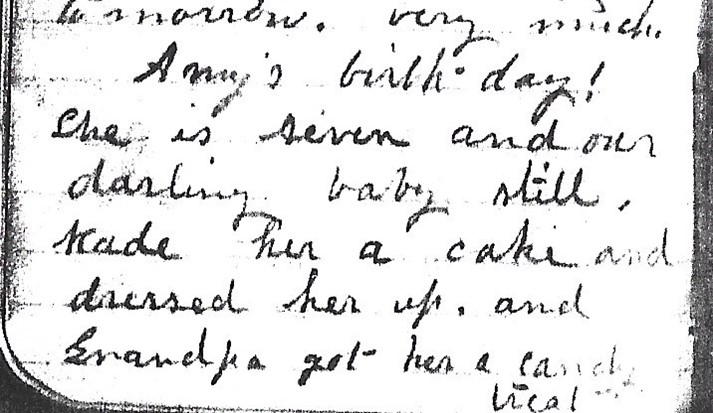
Courtesy Sweetser family collections.
Throughout her teens, Amy was her mother’s greatest help. She was efficient, energetic, and tenacious. Even after she married Elvin Sweetser in 1900 and moved to her new home across the river, Amy remained close to her mother. In 1910 Charles Richardson built a large house in town on Third Street and sold their farm. In 1917 he passed away, and in 1918 Amy and Elvin’s four year old son, Louis, died from measles.
Soon after they lost Louis, Amy and Elvin began dividing the year between the Richardson house on Third Street and the farm, which supported the family in both places. In the winter Elvin commuted daily from town to the Higgins Road to attend livestock. Amy was thrifty and supplemented their income by selling preserves, butter, surplus garden produce, and by singing at funerals. She sewed constantly so that she and her daughters could have the latest fashions for the least cost. They lived well, but they worked themselves and their children hard to do it.
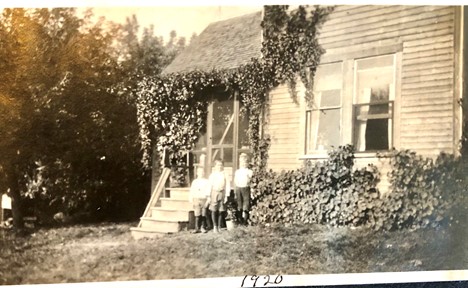
Courtesy Sweetser family collections.
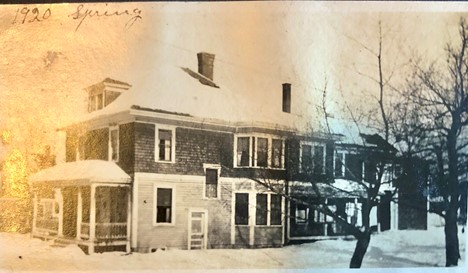
Courtesy Sweetser family collection.
Mobility was essential to Amy’s work. She handled horses confidently. She drove her cars fast, and she was often on the road picking up piglets for the farm, visiting neighbors, taxiing children and hired help, driving cross country to pick strawberries, attending church and club meetings, or enjoying picnic outings and road trips with the whole family. She loved horse racing and the occasional car races at the fair.
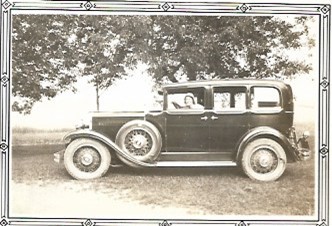
Courtesy of Sweetser family collections.
In 1920, the year of her first extant diary, Amy was 44 with five children: two daughters, Addie Junior and Blanche, ages 19 and 15, three sons, Lawrence, 10, and twins Ralph and Richard age 8.
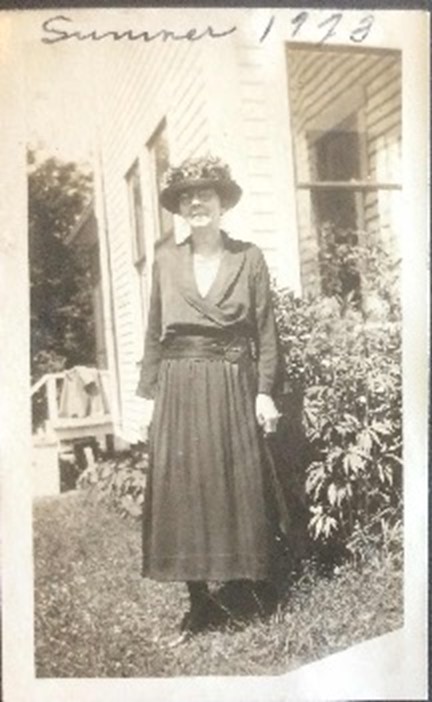
Courtesy Sweetser family collection.
Amy saw to it that the family was mostly food self-sufficient. Hens, dairy and beef cattle, pigs, a wheat crop, orchards, gardens, wild-growing greens, berries and nuts supplied nearly everything except for necessities such as sugar, yeast, coffee, tea and spices.
Planting time began in May, made stressful that year by a week of sore throat and headaches, for which Amy had no time off. The move from town took a couple of days to finish. She made constant use of the new milk separator. The pine floor where she stood to operate it still has ghostly imprints from three decades of her feet. Memorial Day at the end of the month brought a bittersweet visit to Louis’s grave. Half the month has no entries.

Courtesy Sweetser family collection.
Mon. 3 Mrs. Richard’s birthday.
Tues. 4. Took a load to the farm clear and cold
Wed. 5. Moved over [to the farm]
Thu. 6. Had a seperator [sic] set up in Shed
Fri. 7. B[lanche] came over. walked got the car fixed so it will go
Sat. 8. Lamoureau [neighbor] sawing wood for us
Tues. 11. harrowing for first time
Fri. 14. sowed wheat A.M. planting P.M. [entries like this served as farm records]
Sun. 16. I have had a bad sore throat & cold in head all the week & no better.
Wed. 19. Clare Lamoreau went into St. Margaret’s Hospital. Mother has a bad cold on lungs.
Thu. 20. Planted sweet peas and nasturtium
Fri. 21. Clare L. operated on this morning
Sat. 22. Blanche and Marion B. walked over [from town]
Sun. 23. Addie came back from church with us. G.A.R. sermon [Grand Army of the Republic]
Mon. 24. Took voile dress up to Mrs. Smith to cut & fit [done while in town doing laundry]
Sun. 30. took flowers out to cemetary [sic]
June, the start of strawberry season, brought the annual mix of end of school year and beginning of summer flurries. Both of Amy’s daughters trained to be teachers at what is now the University of Maine at Presque Isle, then called the Normal School. The family found time to play together and to attend their various club events. Eight days have no entries.
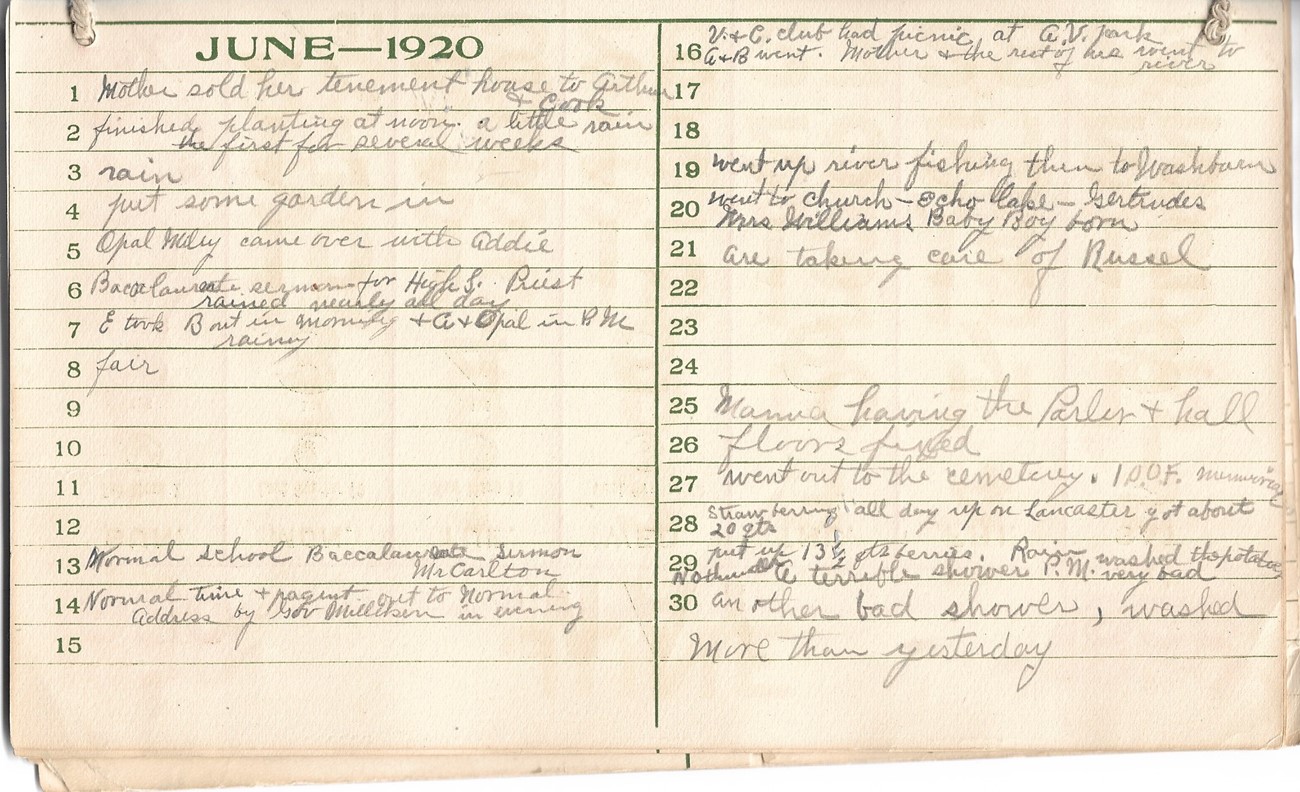
Courtesy Sweetser family collection.
Tues. 1. Mother sold her tenement house to Arthur & Cook
Wed. 2. finished planting at noon. A little rain the first for several weeks.
Thu. 3. Rain
Fri. 4. put some garden in
Sat. 5. Opal Wiley came over with Addie
Sun. 6. Baccalaureate sermon for High S. Priest Rained nearly all day
Mon. 7. E[lvin]took B[lanche] out in morning and A[ddie] & Opal in P.M. rainy
Tue. 8. Fair
Sun.13. Normal School Baccalaureate Sermon Mr. Carlton
Mon. 14. Normal Time & Pagent [sic] out to Normal. Address by Gov. Milliken in evening
Wed. 16. V. & C. Club had picnic at A.V. Park A&B went. Mother & the rest of us went to river
Sat. 19. Went up river fishing then to Washburn
Sun. 20. Went to church—Echo Lake—Gertrude’s [made a call] Mrs. Williams Baby Boy born
Mon. 21. [We] are taking care of Russell [hired couple’s child]
Fri. 25. Mamma having the parlor & hall
Sat. 26. floors fixed [two day project at Third Street house]
Sun. 27. went out to the cemetery. I.O.O.F. missionary[?] [Independent Order of Odd Fellows]
[chicken penciled on calendar date. Possibly what she took to the IOOF meeting]
Mon. 28. Strawberrying all day up on Lancaster got about 20 qts.
Tue. 29. Put up 13 ½ qts berries. Northwester a terrible shower p.m. Rain washed the potatoes P.M. very bad
Wed. 30. another bad shower, washed more than yesterday.
July is haying month, among the most urgent times for livestock farmers who muster every family member in a race to cut and dry grasses at peak nutrition, then gather them in, and who are inevitably thwarted by rain and humidity. Amy’s sister Lizzie married Arthur Hoyt, so references to Hoyt’s indicate extended family. Ten days have no entries and three record one of Amy’s taxi tasks: transporting carpenters.
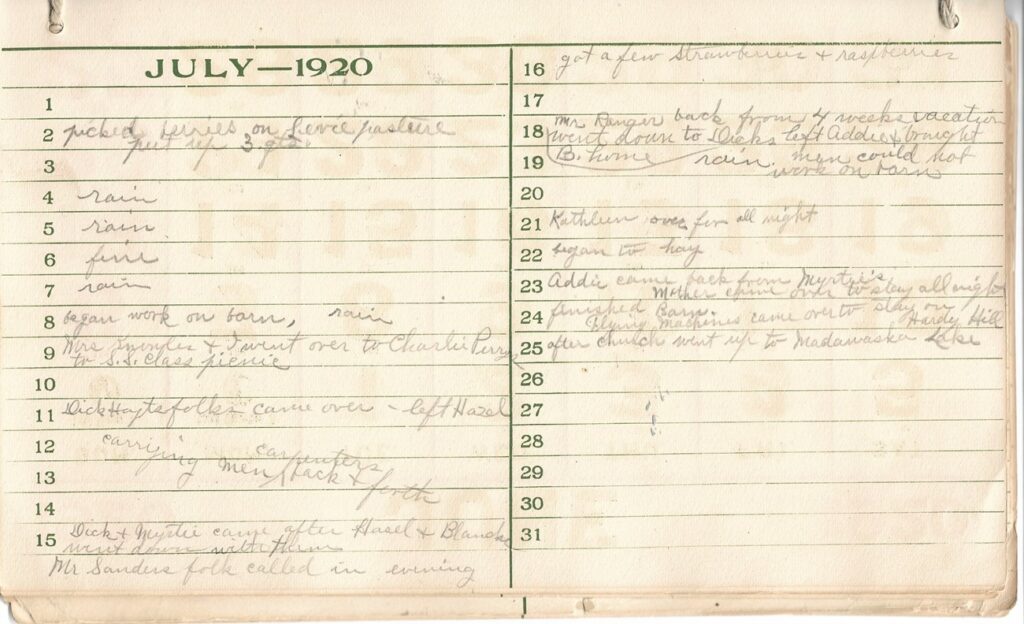
Fri. 2. picked berries on Levie [sic Levi Knowles, neighbor] pasture put up 3 qts.
Sun. 4. rain
Mon. 5. rain
Tue. 6. fine
Wed. 7. rain
Thu. 8. began work on barn [Elvin added new stable with a cement cellar] rain
Fri. 9. Mrs. Knowles & I went over to Charlie Perry’s to S.S. Class picnic. [Sunday School]
Sun. 11. Dick Hoyts folks came over—left Hazel
Mon. 12. Carrying carpenters
Tue. 13 men ^ back &
Wed. 14 forth
Thu. 15. Dick & Myrtie came after Hasel [sic] & Blanche went down with them [to Third Street] Mr. Sanders folk called in evening
Fri. 16. got a few strawberries & raspberries
Sun. 18. Mr. Ranger back from 4 weeks vacation. went down to Dick’s left Addie & brought B home
Mon. 19. rain men could not work on barn
Wed. 21. Kathleen over for all night
Thu. 22. began to hay [very late start.]
Fri. 23. Addie came back from Myrties Mother came over to stay all night.
Sat. 24. finished Barn. Flying machines came over to stay on Hardy Hill [south side of Aroostook River, visible from Higgins Road and Third Street]
Sun. 25. after church went up to Madawaska Lake
July’s last four entries capture the “Dailiness” of Amy’s life. Established routines with family, household, and farm work carried on. Rain had delayed not only the barn construction, but more urgently, the beginning of hay harvest. However, on Saturday folks enjoyed the unexpected pleasure of watching flying machines land on nearby Hardy Hill. Sunday the family all went to church, and then had themselves a picnic at Madawaska Lake. Meanwhile the cut hay was finally curing in the field.
[1] These unpublished diaries are in the possession of two of Adwina Richardson’s great grandchildren: Miriam Hoyt Gregg, who has generously allowed me to make use of Addie’s; Wayne Sweetser, my husband, who holds Amy’s. Miriam and Wayne live in Presque Isle, Maine.
[2] Aptheker, Tapestries of Life, pp 40-60.

Pingback: Diaries of August 1920: “More to life than the daily grind” | Rural Women's Studies